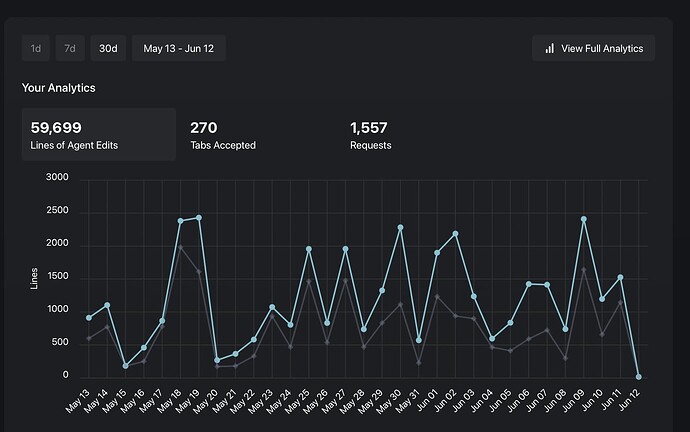your guy’s ratios of proposed vs. accepted lines humble me to a level I would like to hide under my desk. seems like I am seriously doing something wrong.
do you guys also mind sharing what your preffered working mode is?
something like is the following being used:
chat, agent, MCP, cursor rules, background agents, …
also, how are the accepted lines calculated? I have many tool calls that do not directly produce code but terminal commands for checking lints etc. does this also count?
this being said… maybe it might also be related to my setup: I use react, two different livesync back-ends, and quite often they are purposefully intertwined, which leads to cascade of me checking if everything is correctly updated across the layers as the AI often misses something. what do you guys code?
happy to hear any insight that I might use towards my improvement.
Can I ask what you use cursor for?Why so many lines?
Massive project.
![]()
![]()
![]()
No Worries.
Agent Thinking Mode, C4ST, MCP only SequentailThinking, Of course some rules, no background agent yet.
I have been working on this project about 6 months single-handedly, and almost 85% done.
You wrote more than 800,000 lines of code in a month. Do you write operating systems?
First time I hear about C4ST and definetively looks like a promising approach. If I understand it correctly, you use visualization as communication means. I also like to do this, but quite often, the AI does not fully get the visualized model and, moreover, the other way around: the AI does not always create correct visualizations (claud 4 sonnet thinking, gemini 2.5 pro), leading to a very disconnected state and lots of manual updates to keep the visuals in sync.
I didn’t get my fingers wet on MCP yet (yea I know, its 06/2025) as I keep telling myself I need to get something differently done first.
Is MCP the key to have bi-directionally synced visuals, thus, the basis for C4ST?
and just to make sure that I atleast understand 50% of what you are doing:
the C4 stands for Context, Containers, Components, and Code as in this article, right? ![]()
![]() No
No
It is a large application.
Sounds complicated. Of course, good planning is very important; as it’s been said many times: failing to plan is planning to fail.
I was handed the project from another developer who had lost direction in the process. I spent several months trying to bring the codebase back on track.
With the current capabilities and a solid plan, I don’t think I would have needed to make so many requests. What took most of my time was solidifying the websocket integration, Celery workflows, and multiple API calls. This flow had to be established across many parts of the system, and getting everything to work together in a unified way took additional months.
In hindsight, if I were given a project like this again, I would dedicate one full month just to create a complete requirements specification — and then explore how to feed that into AI.
I’ve even considered building a graph database to map the application’s internal connections, and creating an MCP that reads from it. This way, Cursor AI could potentially guide itself in MAX mode.
thanks so much for sharing your experience.
in the meanwhile I also got from your other posts what C4ST probably means: Claude-Sonnet-4-Thinking ![]()
![]()
Sure ![]()
my bad
Haha! ![]()
![]()
0 Tabs ![]() , I’m a developer with approximately 25 years of experience. I’ve learned many languages since the beginning.
, I’m a developer with approximately 25 years of experience. I’ve learned many languages since the beginning.
For the past few months, I’ve been generating 100% of my code with AI — and I will never write code manually again.
If you have strong logic and know how to build a great plan, that’s the key. You absolutely have to commit at every step of your projects (fix, feat, etc.).
Things are moving incredibly fast right now. I wish I had started my career with tools like these instead of debugging with books.
I’ll say that a lot of my requests have been trial and error. It’s taken quite a bit of effort to gain competence with Cursor; especially keeping the models from running off into the weeds to build stuff they shouldn’t, etc. I’m hooked!
Sometimes less is more.
Hi everyone!
I wanted to share my experience after a little over two months immersed in AI-assisted programming and, especially, using Cursor.
I’m a developer with more than 25 years of experience and, although I’ve seen many tools and methodologies evolve, I’ve rarely been as impressed as I have been in the past month and a half since I started working with Cursor. After spending time understanding how it works and setting up my projects, I’ve been able to start new ideas, make progress on others that I had left unfinished, and even dare to fix bugs in old projects—all in different programming languages! I’ve even tried out some languages I had never used before, simply because the barrier to entry is now much lower.
What stands out most to me is how easy it is to tackle tasks that used to be tedious, how quickly I can learn and improve in new languages, and, above all, the ability to generate detailed documentation in just minutes. Creating tests in different languages is another feature I really value.
I honestly can’t fully describe the feeling of seeing my projects move forward, the improvement in code quality, and the productivity I’m achieving. I truly don’t see myself going back after this.
Best regards to everyone, and thanks for this space to share experiences!









